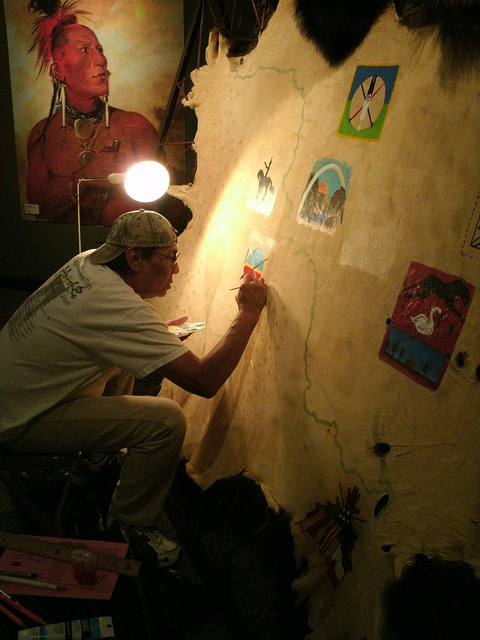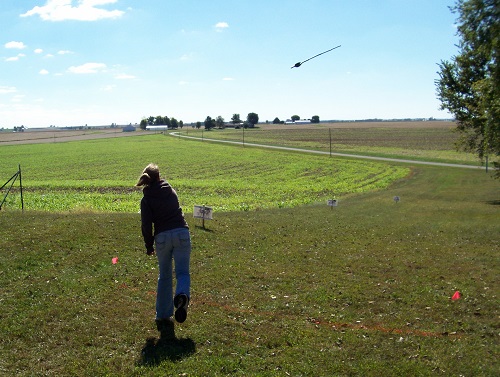at Annie and Abel Van Meter State Park
 Missouri’s American Indian Cultural Center at Annie and Abel Van Meter State Park houses both permanent and temporary displays that interpret the cultural history of the resident tribes of Missouri. These include the Otoe-Missouria, Osage, Delaware, Ioway, Ilini-Peoria, Kanza, Kickapoo, Sac and Fox, and Shawnee. In addition, William Clark, superintendent of Indian Affairs in 1813, is interpreted. Temporary displays also interpret various cultural and natural aspects of American Indians, Annie and Abel Van Meter State Park and Missouri.
Missouri’s American Indian Cultural Center at Annie and Abel Van Meter State Park houses both permanent and temporary displays that interpret the cultural history of the resident tribes of Missouri. These include the Otoe-Missouria, Osage, Delaware, Ioway, Ilini-Peoria, Kanza, Kickapoo, Sac and Fox, and Shawnee. In addition, William Clark, superintendent of Indian Affairs in 1813, is interpreted. Temporary displays also interpret various cultural and natural aspects of American Indians, Annie and Abel Van Meter State Park and Missouri.
Programs at the park will either be conducted in the cultural center or in the picnic area, depending on their nature. Two to three classes can be accommodated in the cultural center, while additional groups go to other areas of the park, including the picnic area's two shelter houses. It is preferred that school groups come to the park for programs due to the amount and sizes of material required to give quality programs.
Staff at the center is small. However, handling multiple classes or groups in one day is possible with assistance from the teachers or group leaders. Four programs at a time in a rotating schedule is the maximum amount that park staff can accommodate. This rotating schedule will usually involve one or more teacher-guided activities.
Interpretive programs listed in this catalog can be scheduled for your class or group. The length of each program has a minimum-maximum range that depends on your group's age range, group size and amount of participation. Programs that are or can be teacher-guided are indicated right after the title of the program. For teachers, the Show-Me Standards are in parentheses at the end of each description.
Annie and Abel Van Meter State Park has several hiking trails that can be led by the teacher or group leader. See the park’s trails page. The park also has a small playground in its picnic area, as well as two shelter houses.
Please call the cultural center at 660-886-7537 to schedule a program for your class or group. It is recommended that you call at least two weeks in advance.
LITTLE FEATHER
(Elementary; 30-45 minutes)
This is a program of everyday life of the Missouria Indians before European Contact. It begins with a six-minute DVD about a fictional Missouria Indian girl named Little Feather. Following the story will be a question-and-answer time in front of the lodge display, using some artifacts and other materials that were mentioned in the presentation. These items will be shown to the children, with some being passed around for them to get a better look or feel of the items. (This program can only be given at the park, not off-site.)
(CA-5, CA-6, SC-4, SC-8, SS-5, SS-6)
 PIECES, PARTS and POOP
PIECES, PARTS and POOP
(Elementary to Adult; 30-45 minutes)
See how American Indians used the bison (buffalo) as a "superstore on hoof." It is an activity where the participants will match modern day items with items American Indians made from all parts of the bison, inside and out. Participants will compare and contrast items and may give a brief informal presentation about their item.
(SC-3, SC-8, SS-2, SS-6, CA-6)
 PRIMITIVE HUNTING SKILLS
PRIMITIVE HUNTING SKILLS
(Upper elementary to adult; 45-60 minutes)
See how American Indians made weapons and honed their hunting skills. They began by first learning their eye-hand coordination through throwing corncob darts through stationary and moving targets. They would then advance to using throwing arrows, followed by graduation to the atlatl. (This program can only be given at the park, not off-site.)
(SC-8, SC-2, HP-4, HP-1 eye/hand coordination)
BEANBAG HUNT
Can be teacher-guided. (Elementary to middle school; 30-45 minutes)
Knowledge of where animals lived, their habits, and what they looked like was essential to the American Indian hunters. This program allows participants to identify and "hunt" the kinds of animals the American Indians and early explorers might have hunted or fished. Pictures of a selection of animals from fish to bison are attached to boards that can be knocked over with beanbags.
(SC-8, SC-3, CA-5, HP-4, HP-1 eye/hand coordination)
THE UN-NATURAL HIKE
Can be teacher-guided. (Elementary to adult; 30-45 minutes)
This program will encourages participants to look carefully at our natural forest environment. Several man-made items will be placed along the Cemetery Trail. The participants will have to walk the trail and look carefully at the forest and all of its natural elements to see those things that do not belong. The items they see are recorded on paper, but not collected. (This program can only be given at the park, not off-site.)
(SC-8, HP-4 Hiking)
NATURE BINGO
Teacher-guided. (Elementary to adult; 30-45 minutes)
This bingo game gets participants to consider how wildlife is organized into groups. The bingo grid is 6 x 6 and each column represents a wildlife group: mammals, birds, plants, amphibians and reptiles, fish and invertebrates. The free spaces are the word NATURE, which is spelled out diagonally from the top left to the bottom right corner. When someone gets a bingo, they call out "NATURE BINGO." Typically, there are small prizes to win, like pencils, etc. An easier version called "EARTH BINGO" is available for lower elementary.
(SC-3, CA-5)
NATIVE AMERICAN BINGO
Teacher-guided. (Upper Elementary to adult; 30-45 minutes)
This bingo game raises the participants’ awareness of different aspects of Native American life. The bingo grid is 6 x 6 and each column represents a different category: dwellings, foods, stone tools, other items, trade goods and Native American tribes. The free spaces are the word NATIVE, which is spelled out diagonally from the top left to the bottom right corner. When someone gets a bingo, they call out "NATIVE AMERICAN BINGO." Typically, there are small prizes to win, like pencils, etc.
(SC-8, SS-6, CA-5)






